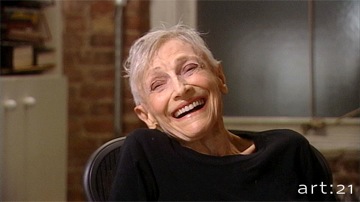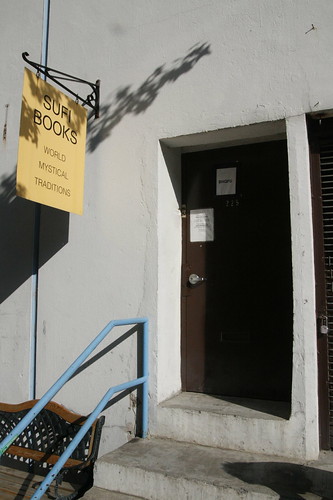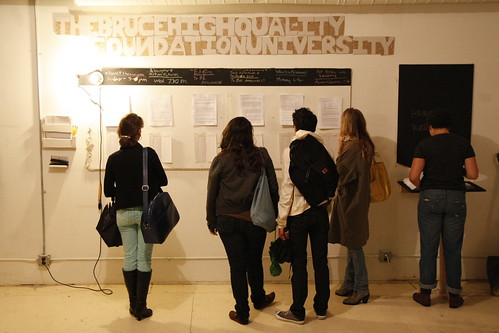Nancy Spero 1926 - 2009
Nancy Spero, artist, feminist, activist, wife, mother, and a great presence in the art world, passed away yesterday. She was 83 years old. The above video snippet from last year's Art:21 gives some idea of her modesty, her fierce intelligence, her unpretentious brilliance. She will be sorely missed.
I knew Nancy and her husband, the artist Leon Golub (1922-2004), particularly in the mid-1980s, when I was curating art exhibitions, and was able to place their work in shows such as Situation, Totem, Body Politic and Stigmata. I showed work from her ongoing series of long paper scrolls with pressed, printed and collaged images of iconic female forms, multicultural pictographs of women through the ages.
From her Wikipedia entry:
I knew Nancy and her husband, the artist Leon Golub (1922-2004), particularly in the mid-1980s, when I was curating art exhibitions, and was able to place their work in shows such as Situation, Totem, Body Politic and Stigmata. I showed work from her ongoing series of long paper scrolls with pressed, printed and collaged images of iconic female forms, multicultural pictographs of women through the ages.
From her Wikipedia entry:
An activist and early feminist, Spero was a member of the Art Workers Coalition (1968-69), Women Artists in Revolution (1969), and in 1972 she was a founding member of the first women’s cooperative gallery, A.I.R. (Artists in Residence) in SoHo. It was during this period that Spero completed her "Artaud Paintings" (1969-70), finding her artistic “voice” and developing her signature scroll paintings: Codex Artaud (1971-1972). Uniting text and image, printed on long scrolls of paper, glued end-to-end and tacked on the walls of A.I.R., Spero violated the formal presentation, choice of valued medium and scale of framed paintings. Although her collaged and painted scrolls were Homeric in both scope and depth, the artist shunned the grandiose in content as well as style, relying instead on intimacy and immediacy, while also revealing the continuum of shocking political realities underlying enduring myths.

In 1974, Spero chose to focus on themes involving women and their representation in various cultures; her Torture in Chile (1974) and the long scroll, Torture of Women (1976, 20 inches x 125 feet), interweave oral testimonies with images of women throughout history, linking the contemporary governmental brutality of Latin American dictatorships (from Amnesty International reports) with the historical repression of women. Spero re-presented previously obscured women’s histories, cultural mythology, and literary references with her expressive figuration.

Developing a pictographic language of body gestures and motion, a bodily hieroglyphics, Spero reconstructed the diversity of representations of women from pre-history to the present. From 1976 through 1979, she researched and worked on Notes in Time on Women, a 20 inch by 210 foot paper scroll. She elaborated and amplified this theme in The First Language (1979-81, 20 inches by 190 feet), eschewing text altogether in favor of an irregular rhythm of painted, hand-printed, and collaged figures, thus creating her “cast of characters.” The acknowledgement of Spero’s international status as a preeminent figurative and feminist artist was signaled in 1987 by her traveling retrospective exhibitions in the United States and United Kingdom. By 1988, she developed her first wall installations. For these installations, Spero extended the picture plane of the scrolls by moving her printed images directly onto the walls of museums and public spaces.

Harnessing a capacious imaginative energy and a ferocious will, Spero continued to mine the full range of power relations. In 1987, following retrospective exhibitions in the United Kingdom, the United States and Canada, the artist created images that leapt from the scroll surface to the wall surface, refiguring representational forms of women over time and engaging in a dialogue with architectural space. Spero’s wall paintings in Chicago, Vienna, Dresden, Toronto, and Derry form poetic reconstructions of the diversity of representations of women from the ancient to the contemporary world, validating a subjectivity of female experience.
Nancy and Leon met at the Art Institute of Chicago in the late 1940s, got married in 1950, traveled and lived together in Europe, had three sons, and moved to their downtown New York studio in 1964. They were married for 53 years, until his death in 2004. She has now gone to join him. They were a great art couple, cherishing each other, challenging each other, proceeding always with fondness and joy.

Nancy Spero. There will not be another like her. R.I.P.

-----------------------------------------------------------------------
Holland Cotter published an obituary of Nancy Spero in yesterday's NY Times. It includes the following text:
One result was a group of pictures in gouache, ink and collage on paper titled “The War Series” (1966-70). With its depictions of fighter planes and helicopters as giant, phallic insects, the series linked military power and sexual predatoriness, but also included women among the attackers. Ms. Spero later described the work as “a personal attempt at exorcism”; it remains one of the great, sustained protest art statements of its era, all the more forceful for its unmonumental scale. Exhibited in 2006 at LeLong Gallery in Manhattan, its pertinence to contemporary politics was unmistakable.
In 1971, Ms. Spero also returned to the interests of her Paris years in the introspective and tormented “Codex Artaud,” a series that interspersed images of broken bodies and hieroglyphic monsters with the transcribed writings of Antonin Artaud (1896-1948), the mentally ill French poet who viewed himself as an outcast from society and who spoke of human folly with a mocking rage. To some degree, the work reflected Ms. Spero’s own sense of exclusion from an art world that had the character of a men’s club.
By the time of the “Codex Artaud” her long involvement with the women’s movement had begun. Ms. Spero was active in the Art Workers Coalition, and in 1969 she joined the splinter group Women Artists in Revolution (WAR), which organized protests against sexist and racist policies in New York City museums. In 1972, she was a founding member of A.I.R. Gallery, the all-women cooperative, originally in SoHo, now in the Dumbo section of Brooklyn. And in the mid-1970s she resolved to focus her art exclusively on images of women, as participants in history and as symbols in art, literature and myth.
On horizontal scrolls made from glued sheets of paper, she assembled a multicultural lexicon of figures from ancient Egypt, Greece and India to pre-Christian Ireland to the contemporary world and set them out in non-linear narratives. Her 14-panel, 133-foot-long “Torture of Women” (1974-1976) joins figures from ancient art and words from Amnesty International reports on torture to illustrate institutional violence against women as a universal condition.
Ms. Spero considered this her first explicitly feminist work. Many others followed, though over time she came to depict women less as victims and more often as heroic free agents dancing sensuously.
Ms. Spero, who always viewed art as inseparable from life, developed a distinctive kind of political work. Polemical but symbolic, it combined drawing and painting as well as craft-based techniques like collage and printmaking seldom associated with traditional Western notions of high art and mastery.
One result was a group of pictures in gouache, ink and collage on paper titled “The War Series” (1966-70). With its depictions of fighter planes and helicopters as giant, phallic insects, the series linked military power and sexual predatoriness, but also included women among the attackers. Ms. Spero later described the work as “a personal attempt at exorcism”; it remains one of the great, sustained protest art statements of its era, all the more forceful for its unmonumental scale. Exhibited in 2006 at LeLong Gallery in Manhattan, its pertinence to contemporary politics was unmistakable.
In 1971, Ms. Spero also returned to the interests of her Paris years in the introspective and tormented “Codex Artaud,” a series that interspersed images of broken bodies and hieroglyphic monsters with the transcribed writings of Antonin Artaud (1896-1948), the mentally ill French poet who viewed himself as an outcast from society and who spoke of human folly with a mocking rage. To some degree, the work reflected Ms. Spero’s own sense of exclusion from an art world that had the character of a men’s club.
By the time of the “Codex Artaud” her long involvement with the women’s movement had begun. Ms. Spero was active in the Art Workers Coalition, and in 1969 she joined the splinter group Women Artists in Revolution (WAR), which organized protests against sexist and racist policies in New York City museums. In 1972, she was a founding member of A.I.R. Gallery, the all-women cooperative, originally in SoHo, now in the Dumbo section of Brooklyn. And in the mid-1970s she resolved to focus her art exclusively on images of women, as participants in history and as symbols in art, literature and myth.
On horizontal scrolls made from glued sheets of paper, she assembled a multicultural lexicon of figures from ancient Egypt, Greece and India to pre-Christian Ireland to the contemporary world and set them out in non-linear narratives. Her 14-panel, 133-foot-long “Torture of Women” (1974-1976) joins figures from ancient art and words from Amnesty International reports on torture to illustrate institutional violence against women as a universal condition.
Ms. Spero considered this her first explicitly feminist work. Many others followed, though over time she came to depict women less as victims and more often as heroic free agents dancing sensuously.




 Bruce Nauman
Bruce Nauman  Hans Ulrich Obrist
Hans Ulrich Obrist
 Henri Matisse, L'Escargot, 1953
Henri Matisse, L'Escargot, 1953 Alma Thomas, Watusi (Hard Edge), 1963
Alma Thomas, Watusi (Hard Edge), 1963